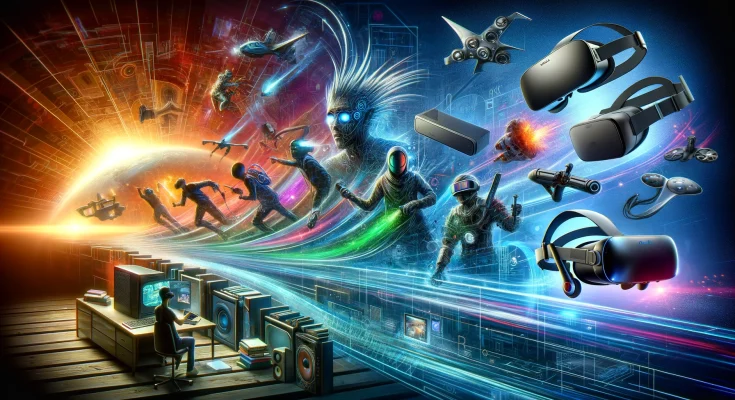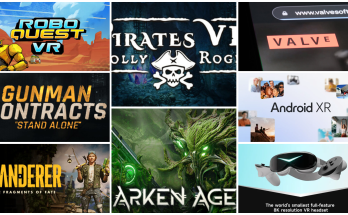Virtual reality (VR) gaming has undergone significant transformation since its inception, with hardware innovations driving an ever-increasing immersion into virtual worlds. From the early days of the Oculus Rift to the high-resolution displays of the Pimax 8K, VR gaming hardware has continually evolved, pushing the boundaries of what’s possible in digital entertainment.
Historical Overview
The journey of modern VR began in earnest with the introduction of the Oculus Rift. Developed from a 2012 Kickstarter campaign, the Rift catalyzed interest in VR with its relatively affordable head-mounted display, designed specifically for video gaming. It was a substantial leap from the rudimentary VR attempts of the 1990s, such as Nintendo’s Virtual Boy, which offered only monochrome visualization and limited interaction.
As Oculus began to refine the Rift, competitors entered the market, each pushing technological boundaries further. The release of the HTC Vive and Sony PlayStation VR in 2016 marked the beginning of competitive commercial VR, with each system bringing its own innovations, from room-scale tracking to integrated game controls.
Technological Advancements
Since those early days, VR headsets have seen improvements across three major areas: design, visual fidelity, and motion tracking. Initial VR headsets were often bulky and uncomfortable for long sessions. Recent models, however, have emphasized ergonomics and lighter materials to improve user comfort. For example, the Oculus Quest 2 uses a soft strap and minimal front-loading weight to reduce fatigue during prolonged use.
Visual fidelity has also improved dramatically. Early VR headsets struggled with screen-door effects and low resolutions. Today’s devices, like the Valve Index and Pimax 8K, boast significantly higher resolutions and refresh rates, drastically reducing visual artifacts and enhancing the sense of presence in VR environments. The Pimax 8K, for instance, offers a resolution of 7680×2160 pixels, providing an almost lifelike visual experience.
Motion tracking has transitioned from external sensors to sophisticated inside-out tracking systems. This shift has allowed for a more straightforward setup and a larger play area, free from the constraints of sensor placement. Advanced algorithms now accurately track player movements directly from the headset, enhancing interaction with the virtual environment without the need for external hardware.
Comparison of Current Models
The current landscape of VR headsets showcases a variety of features tailored to different users. The Oculus Quest 2 offers wireless operation and a self-contained system with no need for a PC, making it an excellent option for ease of use and portability. On the other hand, the Valve Index provides one of the best-in-class audio-visual experiences, ideal for users who prioritize high-quality game graphics and sound.
Furthermore, the field of view (FOV) — a critical component for immersive VR — has seen significant enhancements. Traditional headsets offered about 100 degrees of FOV, while newer models like the Pimax 8K expand it to 200 degrees, closely mimicking human vision.
Future Projections
Looking ahead, the future of VR gaming hardware seems poised for exciting developments. Wireless technology will likely become standard across all devices, removing the physical tethering limitations that currently hamper full immersion. Battery technology and power efficiency will also improve, allowing for longer play sessions.
Additionally, as VR becomes more mainstream, we can expect further integration with other technologies like augmented reality (AR) and mixed reality (MR), leading to new forms of hybrid gaming experiences. These advancements will not only enhance the visual and interactive aspects of gaming but also broaden the applications of VR beyond entertainment into fields such as education, training, and remote work.
In conclusion, the evolution of VR gaming hardware from the Oculus Rift to today’s sophisticated systems illustrates a vibrant and rapidly advancing technology sector. With each iteration, VR headsets become more immersive, more comfortable, and more accessible, promising to revolutionize not only how we play games but how we interact with digital content. As we look to the future, the potential for further innovation holds exciting prospects for gamers and technophiles alike.
From the Oculus Rift’s debut to the advanced systems of today, VR gaming hardware has made monumental strides. Each generation of VR headsets has brought us deeper into immersive worlds, with enhancements in comfort, visual quality, and interaction. Looking to the future, the possibilities for innovation continue to excite and promise to revolutionize not just gaming, but how we engage with all digital content. For gamers and tech enthusiasts, the evolution of VR hardware offers a thrilling glimpse into a future rich with potential and new experiences.








